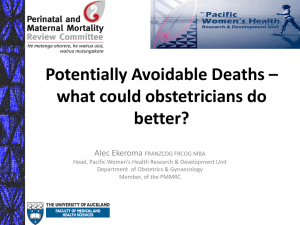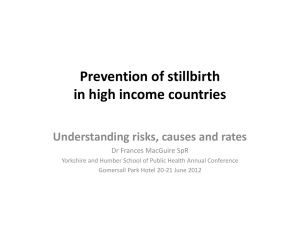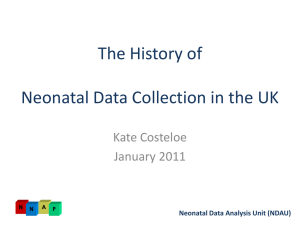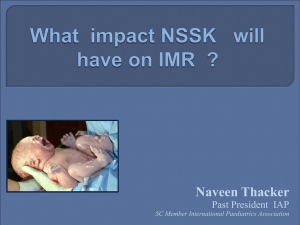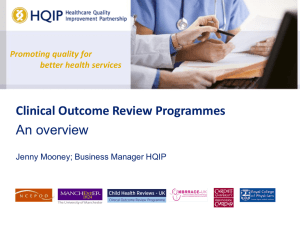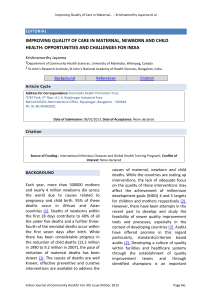here - International Stillbirth Alliance
advertisement
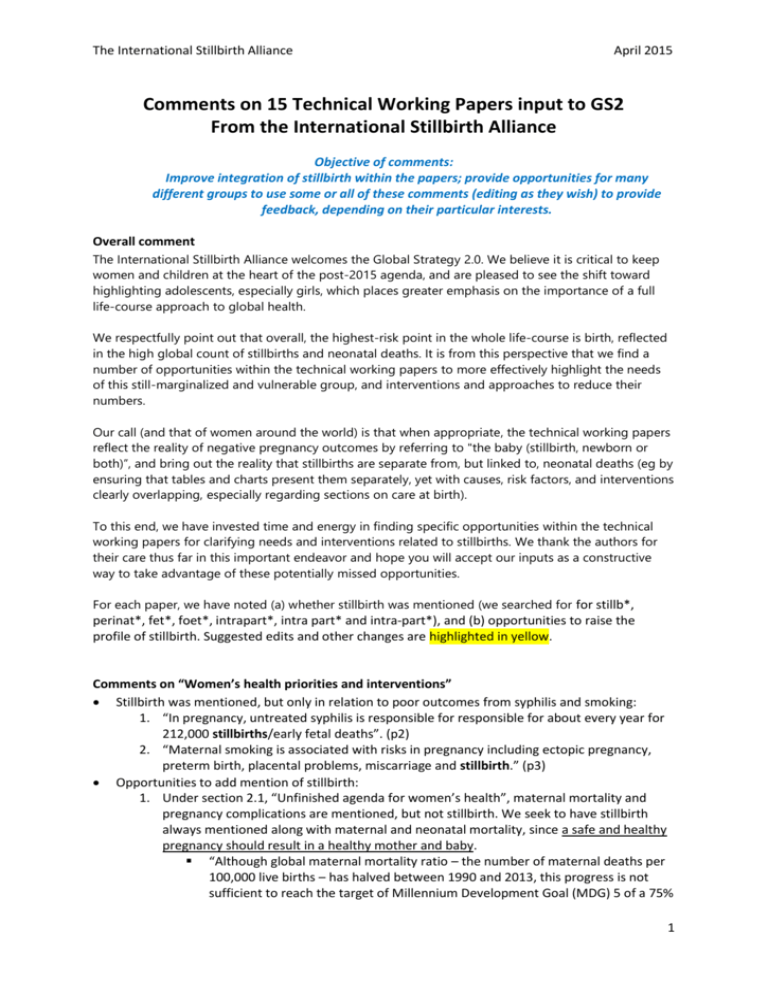
The International Stillbirth Alliance April 2015 Comments on 15 Technical Working Papers input to GS2 From the International Stillbirth Alliance Objective of comments: Improve integration of stillbirth within the papers; provide opportunities for many different groups to use some or all of these comments (editing as they wish) to provide feedback, depending on their particular interests. Overall comment The International Stillbirth Alliance welcomes the Global Strategy 2.0. We believe it is critical to keep women and children at the heart of the post-2015 agenda, and are pleased to see the shift toward highlighting adolescents, especially girls, which places greater emphasis on the importance of a full life-course approach to global health. We respectfully point out that overall, the highest-risk point in the whole life-course is birth, reflected in the high global count of stillbirths and neonatal deaths. It is from this perspective that we find a number of opportunities within the technical working papers to more effectively highlight the needs of this still-marginalized and vulnerable group, and interventions and approaches to reduce their numbers. Our call (and that of women around the world) is that when appropriate, the technical working papers reflect the reality of negative pregnancy outcomes by referring to "the baby (stillbirth, newborn or both)”, and bring out the reality that stillbirths are separate from, but linked to, neonatal deaths (eg by ensuring that tables and charts present them separately, yet with causes, risk factors, and interventions clearly overlapping, especially regarding sections on care at birth). To this end, we have invested time and energy in finding specific opportunities within the technical working papers for clarifying needs and interventions related to stillbirths. We thank the authors for their care thus far in this important endeavor and hope you will accept our inputs as a constructive way to take advantage of these potentially missed opportunities. For each paper, we have noted (a) whether stillbirth was mentioned (we searched for for stillb*, perinat*, fet*, foet*, intrapart*, intra part* and intra-part*), and (b) opportunities to raise the profile of stillbirth. Suggested edits and other changes are highlighted in yellow. Comments on “Women’s health priorities and interventions” Stillbirth was mentioned, but only in relation to poor outcomes from syphilis and smoking: 1. “In pregnancy, untreated syphilis is responsible for responsible for about every year for 212,000 stillbirths/early fetal deaths”. (p2) 2. “Maternal smoking is associated with risks in pregnancy including ectopic pregnancy, preterm birth, placental problems, miscarriage and stillbirth.” (p3) Opportunities to add mention of stillbirth: 1. Under section 2.1, “Unfinished agenda for women’s health”, maternal mortality and pregnancy complications are mentioned, but not stillbirth. We seek to have stillbirth always mentioned along with maternal and neonatal mortality, since a safe and healthy pregnancy should result in a healthy mother and baby. “Although global maternal mortality ratio – the number of maternal deaths per 100,000 live births – has halved between 1990 and 2013, this progress is not sufficient to reach the target of Millennium Development Goal (MDG) 5 of a 75% 1 The International Stillbirth Alliance April 2015 reduction by 2015. It is estimated that in 2013, 289 000 women died from complications in pregnancy and childbirth and that, in 2008, 22 million unsafe abortions occurred (half all induced abortions in that year), nearly all in low- and middle-income countries. [ADD: Each year, ~5.4 million women endured pregnancies that ended in stillbirth (2.6 million; data for year 2009) or neonatal death (2.8 million; data for year 2013).] Further, worldwide, 222 million women are estimated to have an unmet need for modern contraception.” (p2) 2. Under section 2.2, “Emerging priorities for women’s health”, maternal mortality is not mentioned, and stillbirth is mentioned only in relation to syphilis and smoking, but safe and healthy mothers and babies should remain a women’s health priority. ADD paragraph: “Despite progress, maternal conditions still constitute the third largest cause-of-death group for women aged 15-29 (13% of all 15-29 deaths 2012) and the fifth-largest for women aged 30-49 (6%) (WHO, Global Health Estimates, 2014, own estimates). A safe and healthy pregnancy should result in a healthy mother and baby, yet in 2013, 289,000 mothers died due to childbirth and 5.4 million pregnancies ended in stillbirth or neonatal death.” (p3) 3. Under section 3.1, “Strengthening health systems and addressing structural determinants of women’s health”, we can use stillbirth to illustrate enduring problems with inequity and women’s health: “Further, women’s health services, particularly sexual and reproductive health services are often not provided at a level of quality that meets human rights standards. The persistence of poor sexual and reproductive health outcomes [ADD: such as stillbirth and neonatal death] among the poor and other marginalized groups, particularly in Africa and South Asia, underscores the need to strengthen the reach, comprehensiveness and quality of health systems.” (p5) Under point 4, on “monitoring and accountability”, the COIA’s recommendations on “establish[ing] a system for registration of births, deaths and causes of death” and “institutionalization of national perinatal audits for prevention and quality of care” should be added. (p6) 4. Under section 3.2, “Priority interventions for women’s health”, reproductive health is mentioned several times but without the other side of the coin—a healthy baby. “Table 2, Summary of priority health interventions and health system enablers for women’s health” includes many interventions which will reduce stillbirth, such as #2 (Sexual and reproductive health services including family planning), 4 (Management of pregnancy complications), 5 (Pregnancy care), 6 (Counselling and birth preparedness), 7 (Skilled care at birth, comprehensive emergency obstetric and newborn care), 8 (Home birth with skilled care and clean practice), 12 (Promotion of healthy behaviours for preventing non-communicable diseases (e.g. tobacco, alcohol, obesity)) and 14 (Adequate nutrition). The connection of these interventions to healthy babies and stillbirth reduction should be acknowledged; this will demonstrate the “triple return” that investments in these interventions can bring. Under sub-section “Strengthening maternal healthcare”, “The effectiveness of maternity care in tackling maternal deaths [ADD: and reducing negative outcomes such as stillbirth and neonatal deaths] is firmly established.” Add a quote from the EWEC Progress Report (“Saving Lives Protecting Futures” March 2015), "Accelerating investments to increase coverage for a set of core essential health interventions would prevent the deaths of 147 million children, 32 million stillbirths and 5 million maternal deaths in 2013- 2035.” “Health care workers should be empowered and provided with the necessary medicines and equipment and must be supported by a functioning health system which includes emergency obstetric and newborn care and strong 2 The International Stillbirth Alliance April 2015 capacity at the secondary level to address complications of childbirth [ADD and reduce stillbirths and neonatal deaths] (p8) 5. Also, reference should be made to these quotes from the EWEC progress report Saving Lives Protecting Futures released March 2015: "The overall pace of scale-up of essential health and enabling services will need to accelerate, particularly in areas where progress has been slower, such as prevention of newborn deaths and stillbirths…" “Building on successes achieved under the Global Strategy, efforts to accelerate gains for women and children in the post-2015 era should particularly aim to address persistent gaps and challenges. … [P]revention of stillbirths demands greater attention and support." The Progress Report further noted that stillbirths are largely preventable, and that intensified action is needed in the highest-burden countries. Comments on “Child health priorities and interventions” Stillbirth is mentioned only in relation to ENAP targets for neonatal mortality. Thanks to the ENAP combination of neonatal deaths together with stillbirths, stillbirths are now slowly becoming recognized as a component of child mortality. However, this is not carried through the rest of the paper. It is logical to position stillbirth on the continuum of child health if a life-course approach is taken, as is supported in this paper, eg “with essential interventions starting from before conception through adolescence”. Opportunities to add mention of stillbirth: 1. Under “Section 1, Background and Introduction”, reinforce that the recommended interventions will also reduce stillbirths—there is no need to add new interventions. “This paper considers essential strategies and interventions to end preventable [ADD stillbirths], newborn and child deaths and promote children’s healthy growth, development and wellbeing in children up to 10 years of age. 2. Under “Section 2, Problem and Rationale, The unfinished agenda for children’s health”, reinforce the overlap between causes of death of children under 5 and causes of stillbirth—to a great extent, they represent a continuum. Add a sentence on stillbirths: “Despite this significant progress, still 6.3 million children less than five years of age continue to die each year, with over 70 % of deaths occurring within the first year of life [ADD: and another 2.6 million die before birth, of whom 1.2 million during labor, just hours or even minutes before birth] "Leading causes of underfive mortality are preterm birth complications (15%), pneumonia (15%), intrapartum-related complications (11%), diarrhoea (9%) and malaria (7%). In addition, 45 % of all under-five deaths are associated with undernutrition, while in the neonatal period, more than 80% of newborn deaths are associated with low birth weight due to prematurity or intra-uterine growth restriction. (Figure 1) [ADD These causes overlap significantly with leading causes of stillbirth globally including infection, congenital anomalies intrapartum-related complications, and fetal growth restriction.] 3. Under the section on “Emerging priorities for children’s health”, “Congenital abnormalities affect an estimated 1 in 33 infants and result in approximately 3.2 million birth defect-related disabilities every year. An estimated 270 000 newborns die during the first 28 days of life every year from congenital anomalies [ADD Congenital anomalies are also a leading cause of stillbirths.] 4. Under section 3, “RESPONSE AND PRIORITY INTERVENTIONS” 3 The International Stillbirth Alliance April 2015 Figure 3 already includes goals for stillbirth as well as child deaths, so the title should be edited: “Figure 3: Selected goals and targets for ending preventable newborn and child mortality [ADD and stillbirths]” 5. Also, reference should be made to these quotes from the EWEC progress report Saving Lives Protecting Futures released March 2015, "The overall pace of scale-up of essential health and enabling services will need to accelerate, particularly in areas where progress has been slower, such as prevention of newborn deaths and stillbirths…" “Building on successes achieved under the Global Strategy, efforts to accelerate gains for women and children in the post-2015 era should particularly aim to address persistent gaps and challenges. … [P]revention of stillbirths demands greater attention and support." "accelerating investments to increase coverage for a set of core essential health interventions would prevent the deaths of 147 million children, 32 million stillbirths and 5 million maternal deaths in 2013- 2035." The Progress Report further noted that stillbirths are largely preventable, and that intensified action is needed in the highest-burden countries. Comments on “Realizing the health and wellbeing of adolescents” Stillbirth was not mentioned, yet adolescent pregnancy is an important problem that is associated with higher rates of stillbirth and neonatal death. Opportunities to add mention of stillbirth: 1. In section on “Maternal mortality and morbidity” (p4), not only is adolescent pregnancy associated with maternal mortality but also with higher rates of stillbirth and NND: “Adolescent girls have high rates of complications from pregnancy, delivery and unsafe abortion. The consequences have implications for future generations, as newborns and infants of adolescent mothers are at higher risk of low birth weight and mortality [ADD ‘Stillbirths and death in the first week of life are 50% higher among babies born to mothers younger than 20 years than among babies born to mothers 20–29 years old.’ [quote from http://www.who.int/maternal_child_adolescent/topics/maternal/adolescent_pr egnancy/en/ accessed 4-8-15] Comments on “Ending Preventable Maternal and Newborn Mortality and Stillbirths” Stillbirth is a key focus of this paper. The comments below reflect in part the comments on other papers in this series. Opportunities to add mention of stillbirth: 1. Under “Priority interventions”, “In order to achieve these targets, essential interventions as presented in Figure 3 have to be implemented at scale, to reach every woman and every newborn [ADD and every baby before birth] 2. “The list is not exhaustive but it does prioritize interventions that will have a significant impact on maternal [ADD and fetal] and newborn survival by addressing the main causes of mortality” 3. Under “STRATEGIC OBJECTIVE 5: Reach every women and every newborn and address inequities in the context of a human rights approach”, “Recognizing that inequity in maternal and newborn health includes systematically uneven quality and not just access, efforts must also ensure that the care that all populations receive high quality care, not just urban or richer families.” [ADD “Work to reduce preventable deaths should reflect a 4 The International Stillbirth Alliance 4. 5. 6. 7. April 2015 recognition that mothers and babies have a right to a safe, health pregnancy and delivery.”] Under “STRATEGIC OBJECTIVE 6: Harness power of parents, families and communities and engage with civil society”, “Parents are important voices for change and shifting social norms. Evidence shows that implementation of community mobilization through facilitated participatory learning and action cycles with women’s groups is beneficial to improve maternal and newborn health, in particular in rural settings with low access to health services.” [ADD However, there is a dearth of parent-led organizations related to stillbirth and neonatal survival and bereavement support, especially in the highestburden countries. Moreover, where parent-led and small, local CSOs do exist, there is often insufficient support, education, and information to help them maximize their potential.] Under “STRATEGIC OBJECTIVE 7: Count every woman, newborn and stillbirth: strengthen measurement capacity and improve data quality to drive improvement and accountability”, “Accurate documentation of the cause of death through registration or special review/surveillance mechanisms, [ADD and the development and use of a global system for classification of causes of neonatal mortality and stillbirth] is critical to address preventable causes of mortality” Under the same Strategic Objective, “Many countries are currently strengthening maternal death surveillance and response as a foundation for improving quality of care and measurement.” [ADD “As per the COIA recommendations from 2012 (Keeping Promises, Measuring Results), institutionalization of national perinatal audits for prevention and quality of care is a key element of this foundation.”] Also, reference should be made to this quote from the EWEC progress report Saving Lives Protecting Futures released March 2015, "accelerating investments to increase coverage for a set of core essential health interventions would prevent the deaths of 147 million children, 32 million stillbirths and 5 million maternal deaths in 2013- 2035." Comments on “Effective interventions and strategies for improving Early Child Development”: Stillbirth was not mentioned, yet many interventions that yield results for early child development will also reduce stillbirth and neonatal death. Also should note that the paper defines “the early childhood years – defined as spanning the prenatal period through to formal school entry”. Opportunities to add mention of stillbirth: 1. Under section 2, “Problem and Rationale,” it is noted that “there is a significant concordance between risks that impact on child survival and those that impact on development;” [ADD “hence interventions to address risks listed in Table 1 will not only improve early childhood development but can also be expected to increase child survival and reduce stillbirth and neonatal death”]. 2. Under section 3, “Response and Priority Interventions”, “Benefits have tended to be greater when the components of early stimulation and parenting support are integrated with health and nutrition interventions, when beginning early (i.e. across the prenatal period and the first three years of life), and when provided for children with greater risks of poor development (e.g. malnourished children, those living in the poorest communities, or experiencing family violence); [ADD “When such interventions do begin in the prenatal period they can have the added benefit of reducing stillbirth and neonatal death, allowing children to survive and continue to benefit as they grow.” 5 The International Stillbirth Alliance April 2015 Comments on “Nutrition and women’s, children’s and adolescents’ health” This paper mentions the need for improved nutrition for pregnant adolescents who are at increased risk of stillbirth and other negative outcomes. However, the same point is not made for pregnant adult women. Reference is made to “The Rome Declaration, which places an emphasis on the life-course approach and calls for special attention to be given to the first 1,000 days of life (from the start of pregnancy to two years of age).” Opportunities to add mention of stillbirth: 1. In section “2. Problem: Modest and uneven progress”, “If she herself [the adolescent girl] is malnourished – with a low body mass index or with short stature – she is at increased risk of complications in pregnancy [ADD such as stillbirth]” 2. “Conversely, if the mother is obese when she starts her pregnancy, she is also at increased risk of complications [ADD such as stillbirth]” 3. In Figure 1, the balloon labelled “fetal and infant malnutrition” points to a balloon labelled “higher mortality rate [ADD and stillbirths] 4. In Table 3, on” Recommended actions to improve women’s nutrition”, “Hypertensive disorders, such as pre-eclampsia, account for up to 40 000 maternal deaths per year [ADD and are a leading cause of stillbirths] 5. Could mention that improved nutrition of all poor/marginalized women can reducesStillbirth. Comments on “Socioeconomic, political and environmental determinants” Stillbirth was not mentioned. But we want to promote thinking about health that includes not only women’s, children’s, adolescents’, maternal and reproductive health, but also specifically stillbirths, because problems and related interventions are often similar, no matter what the group. We want to remind readers that things that are problematic for women and children are also often associated with stillbirth, and therefore interventions to reduce these problems are also often effective at reducing stillbirths. Opportunities to add mention of stillbirth: 1. In the section on “Problem statement”, “Diarrhoea, malaria and respiratory infections remain among the greatest single causes of under- 5 child mortality, [ADD and are also implicated in many stillbirths], and environmental factors play a significant role in their etiology. Comments on “Technical paper: Health systems resilience and health workforce for women’s, children’s and adolescents’ health” Stillbirth was not mentioned. Still, it is desirable to remind readers that an “outcome” of a strong health workforce is lower neonatal mortality and stillbirths. Opportunities to add mention of stillbirth: 1. Under “response and priority interventions” (p5), “Similarly, accelerated reductions in maternal and newborn mortality [ADD and stillbirths as called for in the Every Newborn Action Plan] will require an accelerated increase in the number and distribution of skilled health professionals, with a particular focus on the midwifery workforce” 2. “Optimizing the competence and capacity of the health work force may not only bring key services such as contraceptive technologies closer to the communities but also improve coverage of key evidence-based interventions such as interventions to reduce [ADD maternal, neonatal and fetal] morbidity and mortality from obstetric complications such as hemorrhage and preeclampsia/eclampsia” 6 The International Stillbirth Alliance April 2015 3. Also, reference should be made to these quotes from the EWEC progress report Saving Lives Protecting Futures released March 2015, a. "The overall pace of scale-up of essential health and enabling services will need to accelerate, particularly in areas where progress has been slower, such as prevention of newborn deaths and stillbirths…" b. “Building on successes achieved under the Global Strategy, efforts to accelerate gains for women and children in the post-2015 era should particularly aim to address persistent gaps and challenges. … [P]revention of stillbirths demands greater attention and support." c. "accelerating investments to increase coverage for a set of core essential health interventions would prevent the deaths of 147 million children, 32 million stillbirths and 5 million maternal deaths in 2013- 2035." d. The Progress Report further noted that stillbirths are largely preventable, and that intensified action is needed in the highest-burden countries. Comments on “Financing the Health of Every Woman, Every Child post-2015” Stillbirth was not mentioned. As with other papers, our intent is to have stillbirth mentioned in conjunction with maternal and neonatal mortality as much as possible, to help cement the understanding that the three are linked, and that to a large extent, investments in one constitute investments in all. Opportunities to add mention of stillbirth: 1. Within the section on “The Investment Case for Women and Children’s Health post2015”, “As the global community transitions from the Millennium Development Goals to a post-2015 world of Sustainable Development Goals, a considerable part of the agenda with regard to maternal and child health remains unfinished, despite the progress made to date as noted earlier. Far too many newborns, children, adolescents, and women still die, [ADD and stillbirths occur] of preventable conditions every year, and far too few have reliable access to quality health services” 2. Under “Five “Strategic Shifts” Going Forward”, “First, we will actively support the Value for Money Agenda - - aiming at more health for the money, more money for health. … Finally at global level, a tax on financial transaction could be seen as generating funding for the expansion of maternal and child health services [ADD as a means to strengthening women’s and children’s health and reducing preventable maternal and neonatal deaths and stillbirths. In valuing investments, greater attention should be paid to those which yield returns on multiple levels and to multiple groups. For instance, many investments for reducing maternal mortality such as emergency obstetric services also reduce neonatal deaths and stillbirths, the so-called “triple return”.]. 3. Also, reference should be made to these quotes from the EWEC progress report Saving Lives Protecting Futures released March 2015, a. "The overall pace of scale-up of essential health and enabling services will need to accelerate, particularly in areas where progress has been slower, such as prevention of newborn deaths and stillbirths…" b. “Building on successes achieved under the Global Strategy, efforts to accelerate gains for women and children in the post-2015 era should particularly aim to address persistent gaps and challenges. … [P]revention of stillbirths demands greater attention and support." c. "accelerating investments to increase coverage for a set of core essential health interventions would prevent the deaths of 147 million children, 32 million stillbirths and 5 million maternal deaths in 2013- 2035." 7 The International Stillbirth Alliance April 2015 d. "Priority areas for the future include adolescent health, prevention of stillbirths, improving food and nutrition, water and sanitation, and work in conflict zones and fragile states" e. The Progress Report further noted that stillbirths are largely preventable, and that intensified action is needed in the highest-burden countries. Comments on “Innovations for Women's, Children's and Adolescents' Health” Stillbirth was mentioned twice: 1. Mentions the Odon Device: “the Odon Device has the potential to prevent 200,000 deaths per year in sub-Saharan Pipeline Curation Brokering Investment Page 5 of 11 Africa (4500 maternal deaths, 111000 stillbirths, and 95000 newborns)”. This is the only time that the triple return is mentioned in this series of working papers (aside from the paper on neonatal deaths and stillbirths). 2. Also mentioned in “Table 1—RMNCAH sub-topics”, under “newborn”. Opportunities to add mention of stillbirth: 1. [EDIT Table 1: stillbirths are not newborns and do not belong in the “newborn” column. In fact, they should occupy a separate column, situated between maternal and newborn. This column should include the following points, all of which also appear in other columns: from the maternal column: “antenatal care, emergency obstetric care, obstruction, pre-eclampsia,” and from the newborn column: “complications during delivery, newborn resuscitation”] 2. Under “Curation”, “There is a need to focus curation activities on conditions with greatest burden and innovations with greatest life-saving and life-improving potential [ADD In valuing investments, greater attention should be paid to those which yield returns on multiple levels and to multiple groups. For instance, many investments for reducing maternal mortality such as emergency obstetric services also reduce neonatal deaths and stillbirths, the so-called “triple return”.]. 3. Also, reference should be made to these quotes from the EWEC progress report Saving Lives Protecting Futures released March 2015, "Priority areas for the future include adolescent health, prevention of stillbirths, improving food and nutrition, water and sanitation, and work in conflict zones and fragile states". Comments on “Realizing the health-related rights of women, children and adolescents health” No mention of stillbirths in this paper, yet many stillbirth-related issues should be rights-related, since mothers and babies have the right to a safe and healthy pregnancy and delivery. Opportunities to add mention of stillbirth: It would be logical to position stillbirths as a rights issue: 1. In the introduction, “Every preventable death poses a challenge to health, development, and human rights initiatives. [ADD Mothers and babies have the right to a safe and healthy pregnancy and delivery which could reduce preventable maternal and neonatal deaths and stillbirths.”] 2. Under the section “Stating the problem”, "One major challenge is that the interlinked root causes of child mortality and morbidity are not systematically identified or adequately addressed; [ADD with stillbirths mostly left out of the equation although it is likely root causes of child mortality overlap greatly with root causes of preventable stillbirths] 3. Under "D. Delivery of rights-based services”, “Health authorities should take measures to reduce infant and child mortality and promote the healthy development of infants 8 The International Stillbirth Alliance April 2015 and children [ADD and reduction of neonatal death and stillbirths, recognizing that all children and mothers have the right to a safe delivery]. 4. Under “F. Accountability”, “Comprehensive data collection, including disaggregation according to factors such as gender, age, ethnicity, socio-economic background, location, disability, civil status, HIV or other status, as well as the collection of qualitative and quantitative data, in order to identify such groups [ADD and to ensure counting of other marginalized groups currently not counted or under-counted such as stillbirths, in particular intrapartum stillbirths—babies who die hours or minutes prior to birth] and analyze and address disparities in access to health care.” 5. Also, reference should be made to these quotes from the EWEC progress report Saving Lives Protecting Futures released March 2015, a. "The overall pace of scale-up of essential health and enabling services will need to accelerate, particularly in areas where progress has been slower, such as prevention of newborn deaths and stillbirths…" b. “Building on successes achieved under the Global Strategy, efforts to accelerate gains for women and children in the post-2015 era should particularly aim to address persistent gaps and challenges. … [P]revention of stillbirths demands greater attention and support." c. "accelerating investments to increase coverage for a set of core essential health interventions would prevent the deaths of 147 million children, 32 million stillbirths and 5 million maternal deaths in 2013- 2035." d. The Progress Report further noted that stillbirths are largely preventable, and that intensified action is needed in the highest-burden countries. Comments on “A Global Strategy for Every Woman Every Child in Every Setting” Stillbirth is not mentioned. Opportunities to raise stillbirth: 1. Under section on “Problem and Opportunity, “60 per cent of preventable maternal deaths and 53 per cent of under-five deaths take place in just such settings: in settings of conflict, displacement and natural disasters. In particular, newborns younger than 28 days old have the highest risk of mortality in these circumstances. [ADD While numbers are not available, it is likely that this pattern is repeated for stillbirths, with much higher risk of stillbirth both before and during birth to babies in conflict and natural disaster settings.] 2. “99% of the 2.9 million newborns deaths [ADD and the 2.6 million stillbirths] that occurred in 2012 took place in low- and middle income countries. Many of the countries with the highest neonatal mortality rates globally are currently or have recently been affected by complex humanitarian emergencies” 3. “At any given time, 4 per cent of any displaced or otherwise disaster-affected population are women who are pregnant and of these, approximately 15 per cent will experience an obstetric complication. Without access to emergency obstetric services, many women die during pregnancy or childbirth and many more suffer long-term health consequences that otherwise are preventable. In these circumstances, many newborns do not survive even their first 24 hours of life, [ADD and many babies die before or during birth].” 4. Under “2.2. Urgent need to broaden the Scope of the EWEC Global Strategy”, “It is crucial, and urgent, that the next EWEC Global Strategy includes clear measures to better support countries and the international community to uphold fundamental human rights across the life-course (younger and older women, newborns [ADD and babies at risk of stillbirth during pregnancy and childbirth], children and adolescents) in every setting, including specifically in emergencies” 9 The International Stillbirth Alliance April 2015 5. In the table on “Newborns and children”, we want to demonstrate that many of these interventions will also reach and benefit another marginalized group, namely babies at risk of death before or during birth. In the header to this table: “Key health conditions to be addressed: ● Child health conditions to be addressed: malaria, pneumonia, diarrhea, measles, malnutrition and mental health and well-being ● Newborn conditions to be addressed: pre-term, LBW, Sepsis, Intra-partum complications [ADD BULLET POINT Reduction of stillbirth to be addressed through the same interventions: intrapartum complications]”. 6. In the table on “Women”, the header is “Key health conditions to be addressed: Pregnancy and child birth, S-GBV, family planning, HIV/AIDS, STIs, emerging diseases (Ebola, cholera and other communicable and noncommunicable diseases), mental health (including post- traumatic stress, trauma) and malnutrition.” [ADD BULLET POINT Reduction of stillbirth to be addressed through the same interventions: Pregnancy and child birth] Comments on “BACKGROUND PAPER ON NATIONAL LEADERSHIP AND OPERATIONALISATION” No mention of stillbirth. No opportunities to raise stillbirth were found. Comments on “Background Paper on Accountability” No mention of stillbirth. No opportunities to raise stillbirth were found. Comments on “Working Paper Series: Advocacy and Communications” Stillbirth is listed, somewhat ironically, as an example of successful advocacy: 1. "Issues framed in a way that resonates with political leaders: Newborn survival and health and prevention of stillbirths were not specifically addressed in the MDGs, and consequently received less attention and investment. Nonetheless, these deaths account for a considerable and growing share of under five deaths globally. This trend was presented as a key rationale for urgent action in ENAP. Building from the strong visibility and commitment to the Born Too Soon report on preterm birth in 2012, ENAP also prioritizes parent-led action and advocacy to push newborns and stillbirths higher on the political agenda." Opportunities to raise stillbirth: 1. Under section “4.2. Strong national, regional, and global coordination platforms”, the point is made that civil society organizations (CSOs) and CSO coalitions are an important component of advocacy activities and could be even more effective in support of RMNCAH with greater support and investment; elsewhere (p5 top) parent-led initiatives are also mentioned. The paper states “In the RMNCAH domain the Global Financing Facility GFF to support Every Woman Every Child is designed to support the development of national financing roadmaps and leveraging of domestic resources for health. However, the GFF business plan does not yet articulate the need to support multi-partner domestic budget advocacy to mobilize and sustain domestic allocations for health. Without such domestic advocacy with parliamentarians, the media and civil society, the GFF ambitions cannot 10 The International Stillbirth Alliance April 2015 be fully realized. The business plan should, therefore, identify how the GFF will support national advocacy, at both the level of principle and concrete support.” [ADD The potential of small, local and parent-led CSOs should also not be overlooked, although they are less likely than the large national or multinational CSOs to engage in higher-level advocacy. There is a dearth of such organizations for many important RMNCAH issues such as stillbirth, especially in the highest-burden countries, and where they do exist, there is often insufficient support, education, and information to facilitate their involvement in advocacy activities.] 11
